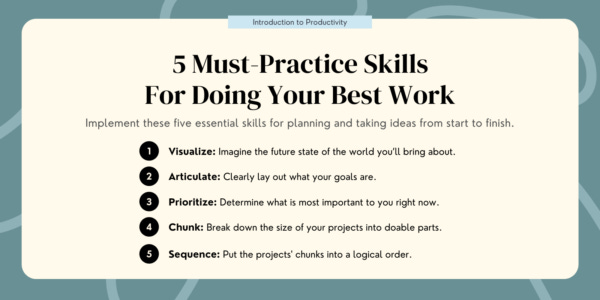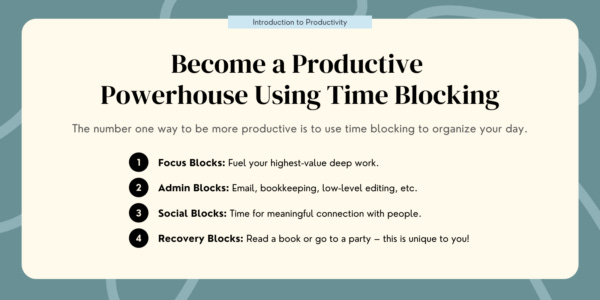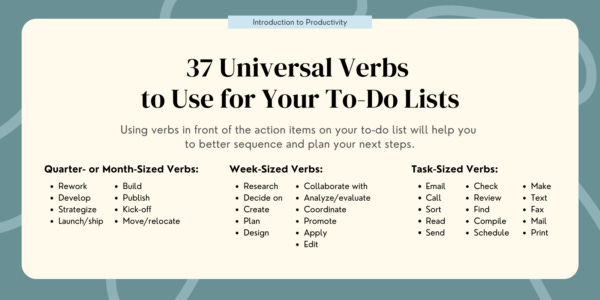The Productive Flourishing Productivity Primer
These 10 key principles and practices won't just help you become more productive - they'll help you thrive
With the website/company name of Productive Flourishing, you’d expect that I write and think a lot about productivity. I do.
But what I often have to remind people is that productive modifies flourishing. What I care most about is what leads to our thriving and I thus take a more holistic perspective on what it means to be productive.
I didn’t set out to make a Top 10 post, and yet, that’s what happened. The following ten principles and practices are a great primer to the productive side of Productive Flourishing.
Ready to start finishing more of your best work? I suggested starting from the top.
1) Manage Your Time, Energy, and Attention
Many of us operate as if more time equals more capacity. But in reality, it often doesn’t. You have to factor in how much time, energy, and attention a project takes you, in order to properly account for your bandwidth.
So how can you better manage your time, energy, and attention? Here are some things to ask yourself:
Gaining time: What are you doing that you could either stop doing or do more efficiently so that there’s less time seepage?
Using time: What would you do with any additional time that you gain? Is the juice worth the squeeze?
Gaining energy: What could you do to increase your available emotional, social, mental, and physical energy?
Losing energy: What are the sources of energy drain in your life? Is there something you can do to address those sources? It’ll probably take more energy to deal with the cause than the symptom, but continually applying Band-Aids has a cost, too.
Gaining attention: What really engages you? What are you naturally drawn to do?
Losing attention (aka being distracted): What’s distracting you or causing you to continually shift focus? Is there a way to alter your environment so you’re less prone to be distracted?
How this makes you more productive: By more accurately accounting for how long it takes a project or task to complete, you’ll be able to better budget how many projects you can sustainably take on.
2) Build A (Success) Pack
Personal productivity is either a misnomer or the least fulfilling and effective way to be productive. We’re inherently social and cooperative creatures who (can) derive so much joy and meaning from working with other humans.
As I say in Start Finishing
Your success pack is the group of people who are going to be instrumentally involved in helping you push your best-work project to done. Think of this group as the rest of the Avengers, the Fellowship of the Ring, the Sisterhood of the Traveling Pants, or the crew of the Enterprise (without the redshirts.)
Call it your cabal, squad, crew, or posse — they’re all different words for your success pack.
But your success pack is more than just a few folks around you. They’re a group made of up:
Guides who help you see the world differently and can say just the right thing to get you unstuck
Peers who soundboard, brainstorm, strategize, co-create, nudge, and walk with you throughout your projects.
Supporters who roll up their sleeves and get in the projects and work with you.
Beneficiaries who both benefit from your best work and who can remind you about the why of the work when your confidence falters.
A counter-intuitive practice that I suggest is to build your success pack before you make the plan and get knee-deep into the work. Too many of us wait until we’re just about out of steam, probably on the wrong road, and about to give up before we invite people in to support us. That’s the hard way and you don’t have to choose that way.
How this makes you more productive: We are stronger, more capable, and better together than we are alone. Your success pack can help you make better plans, bring in more resources, and keep you going — and often keep you from getting stuck, isolated, and demoralized to start with.
3) Practice These Five Crucial Skills
We’ve determined the five important skills you need to understand your goals, properly plan, and take your ideas from start to finish. While you might not be able to truly master all five, picking a few to focus on will no doubt increase your productivity.
These are the five skills that we’ve found are most important for optimizing your productivity:
Visualize: Imagine the future state of the world you’ll bring about.
Articulate: Clearly lay out what your goals are.
Prioritize: Determine what is most important to you right now.
Chunk: Break down the size of your projects into doable parts.
Sequence: Put the projects' chunks into a logical order.
How this makes you more productive: You can use any number of tools to get projects done, but you’ll always use the five skills outlined here, which is why it’s critical you start to get a grasp on them.
4) Stick to the Five Projects Rule
We know, we know – you’ve got a lot of great ideas for projects swirling around. But the truth is that most people have committed to too many projects, especially when you think about the personal projects you have going on, too. The Five Projects Rule is powerful because it helps you look at your projects critically, in an effort to help you finish your best work.
The Five Projects Rule is an important shorthand because it hones in on the five critical aspects of finishing your best work by helping you:
Prioritize on the front end because it constrains your choices.
Focus on the important projects because it’s a manageable number of projects that you can remember off the top of your head.
Plan your projects because it thwarts creating too-detailed plans than what’s needed and creating plans for projects you’re not going to be able to do in the timeframe in question.
“Fund” your projects with the blocks of time you’ll need to spend on them.
Shift and sequence projects as the inevitable emergent projects come up.
How this makes you more productive: The five projects rule allows us to check our commitments and do routine planning quickly, thus saving us time to actually work on the aforementioned projects.
5) Set SMART Goals
Take a look at the goals you are trying to achieve. These goals can be as broad as your bucket list travel dreams or as narrow as your daily to-do list of laundry and dishes. No matter what your goals are, ask yourself: are they SMART? If not, is it possible to break up your goals into smaller goals that do fit this criteria?
Thinking about your goals and productivity using this framework has two major benefits: it ensures that you’re thinking in a considered way about the commitments you’re making to yourself, and it helps you express your goals in a way that makes it more likely that you’ll complete them.
Here is how you can identify if your goal is indeed SMART:
Simple: A goal is simple when you can look at it without wondering.
Meaningful: A goal is meaningful when you understand why you're completing that goal.
Actionable: A goal is actionable when it’s clear what needs to happen to accomplish the goal.
Realistic: A goal is realistic when the endpoint is achievable with the resources you have available.
Trackable: A goal is trackable when it’s clear what progress means.
How this makes you more productive: Being stuck with an idea that’s not yet a goal keeps you swimming in the ocean of possibility, which is fun for a little while but exhausting over the long term. Converting that idea into a goal gives you a safe shore to swim to.
6) Break Your Projects Down
Being able to think of the next action in a project is a great way to make your ideas actionable, but when you get serious about moving on that project, you’ll have to start thinking in terms of project chunks. By breaking – or "chunking" – your projects down into manageable parts, you’re more likely to get them done.
There’s a bit of an art to chunking projects down, mostly because you have to keep two variables in mind: what are the discrete elements of the project, and how much detail do you need to include to drive action for the project?
Here are a few other tips that’ll help you chunk your projects:
At this stage in the game, try to think just about the WHAT aspects of the project, not about WHEN you’ll do it. Put the pieces of the puzzle on the table before you start trying to put them together in the right way.
Start each chunk with a verb. It’ll help you remember what actions need to be taken to move the project forward. (We’ll talk more about the importance of verbs later in this guide.)
Use the Two-Hour Rule as a guideline for your chunks. A natural question people have about chunking is how much to chunk projects down. The Two-Hour Rule comes in handy here, for the simple reason that we generally know how much we can get done in two focused hours and it allows us to start creating standard units of creative time for projects.
How this makes you more productive: As Henry Ford infamously said, “Nothing is particularly hard if you divide it into small jobs.” Completing smaller tasks is more satisfying, so we’re more likely to do them, thus moving projects along.
7) Use Time Blocking In Your Schedule
Once you’ve identified the skills you need to set better goals and organize which projects are at the top of your priority list, the number one way to optimize your productivity is to use time blocking in your planner and to organize your day. Rather than thinking about time in an open, unstructured way, time blocking helps to create a coherent daily structure with four different kinds of blocks based upon the type of activity done in those blocks.
Here are those four basic blocks:
Focus blocks are 90–120 minute blocks of time where you’re especially creative, inspired, and able to do high-level work that requires focus.
Admin blocks are 30–60 minute lower-energy blocks of time where you’re not in the zone to do the work that requires heavy lifting, but there are still other types of work you can do effectively.
Social blocks are 90–120 minute blocks of time where you’re primed and energetically in the right space to meet with other people.
Recovery blocks are variable-length blocks of time that you use for exercise, meditation, and self-care. Pro tip: Recovery looks different for everyone. Maybe recovering looks like reading a book, or maybe that means going to a party.
How this makes you more productive: Using these four types of time blocks can make planning much easier and feel more natural, because a lot of the decision work about where things go is already solved.
8) Write Better Action Items
Do the items on your to-do lists tell you what actually needs to be done? As it turns out, the way most people are formulating action items simply isn’t helping them. A well-written action item contains enough information to spur you into action rather than just serving as an anchor for you to then remember what needs to be done.
There are seven things you can do to increase your productivity and start writing better action items today:
Remember that the capture phase is different from the process phase.
Write each action item as if you were writing it to someone else.
Use verb-noun constructs at the beginning of the action item and all the way up.
If it needs to be done by a certain time, include the “when” in the task.
In team environments, always assign ownership for the action item.
Be clear about relay items.
Give context as a comment or note.
How this makes you more productive: Creating the most optimized, effective plan for your day, week, month, quarter, and year is one of the most important ways to keep your goals clear and know exactly what it is you need to do to achieve them.
9) Use Better Verbs on Your To-Do List
Ready to earn some extra credit on your to-do list, and really start to get productive? Use better verbs in your plans. A common trip-up when people are making their to-do lists is that they’re either not using verbs in front of action items or the verbs aren’t working for them.
But more than just providing more verbs, the key insight is that the verbs themselves hint at what size of project you’re dealing with. Furthermore, these verbs create natural sequences. Thus, using these verbs consistently helps you chunk, sequence, and plan your action steps – all things that we already know will make you more productive.
How this makes you more productive: Similar to writing better action items, by dialing in your planners as much as possible, you’ll be able to better articulate what exactly it is that you need to do for each task on your list.
10) Prevent Burnout by Having Boundaries
With being more productive and juggling many projects, it’s all too easy to slip into feeling burned out. So in an effort to avoid that completely, it’s important to set firm boundaries from the get-go so you can protect your physical and mental health while setting realistic expectations for those around you.
How this makes you more productive: Being too burned out to get out of bed means that nothing gets done. But, more importantly, remember this: resting is being productive, too.
Becoming more productive is all about optimizing all parts of your day in small but mighty ways. When you’re able to think more thoroughly about your entire project plan, as well as the way your energy flows throughout the day, you’ll be better able to get more done with more ease. By managing your time, getting realistic about your goals, cultivating meaningful skills, using time blocking, and writing better plans, you too can achieve peak productivity in your work and your life.
And remember: The aforementioned practices for bettering your productivity are just that; practices. Be patient while you get into a better workflow, embrace the learning experiences, and remember that we’re all a work in progress.
Which practices resonated most with you? Which ones are you excited to start trying today? We’d love to hear about it!










That was so cool to understand it. https://www-ktag.com